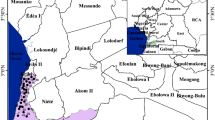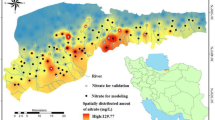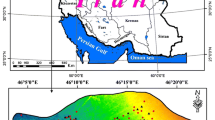Abstract
The goal of the present research is to evaluate three bivariate models of the frequency ratio, Shannon entropy (SE) and evidential belief function in the spatial prediction of groundwater at the Sero plain located in west Azerbaijan, Iran. In the first phase, well locations with groundwater yields \({>}11\hbox { m}^{3}\)/hr were identified (75 well locations). Ten groundwater conditioning factors affecting the occurrence of groundwater, namely, altitude, slope degree, curvature, slope aspect, rainfall, soil, land-use, geology and distance from the fault and the river, were selected for modelling. Finally, the groundwater potential map results were drawn from three implemented models and they were validated using testing data by area under the receiver operating characteristic curve (AUC). The AUCs of these models were 0.84, 81 and 85%, respectively. The results of the current study demonstrated that these models could be successfully employed for spatial prediction modelling. Moreover, the results of the SE model demonstrated that the most and the least important factors in groundwater occurrences in the area under study were altitude, curvature and rainfall, respectively. The results of this study are helpful for the Regional Water Authority of Urmia and the decision makers to comprehensively assess the groundwater exploration development and environmental management in future planning.






Similar content being viewed by others
References
Adiat K A, Nawawi M N and Abdullah K 2012 Assessing the accuracy of GIS-based elementary multi criteria decision analysis as a spatial prediction tool – A case of predicting potential zones of sustainable groundwater resources; J. Hydrol. 440 75–89.
Akgun A 2012 A comparison of landslide susceptibility maps produced by logistic regression, multi-criteria decision, and likelihood ratio methods: A case study at İzmir, Turkey; Landslides 9(1) 93–106.
Althuwaynee O F, Pradhan B, Park H J and Lee J H 2014 A novel ensemble bivariate statistical evidential belief function with knowledge-based analytical hierarchy process and multivariate statistical logistic regression for landslide susceptibility mapping; Catena 114 21–36.
Awawdeh M, Obeidat M, Al-Mohammad M, Al-Qudah K and Jaradat R 2014 Integrated GIS and remote sensing for mapping groundwater potentiality in the Tulul al Ashaqif, Northeast Jordan; Arab. J. Geosci. 7(6) 2377–2392.
Bastani M, Kholghi M and Rakhshandehroo G R 2010 Inverse modeling of variable-density groundwater flow in a semi-arid area in Iran using a genetic algorithm; Hydrogeol. J. 18(5) 1191–1203.
Bednarik M, Magulová B, Matys M and Marschalko M 2010 Landslide susceptibility assessment of the Kral’ovany–Liptovský Mikuláš railway case study; Phys. Chem. Earth A/B/C 35(3–5) 162–171.
Carranza E J, Woldai T and Chikambwe E M 2005 Application of data-driven evidential belief functions to prospectivity mapping for aquamarine-bearing pegmatites, Lundazi district, Zambia; Nat. Resour. Res. 14(1) 47–63.
Chen W, Panahi M, Khosravi K, Pourghasemi H R, Rezaie F and Parvinnezhad D 2019 Spatial prediction of groundwater potentiality using ANFIS ensembled with teaching-learning-based and biogeography-based optimization; J. Hydrol. 572 435–448.
Chowdhury A, Jha M K, Chowdary V M and Mal B C 2009 Integrated remote sensing and GIS-based approach for assessing groundwater potential in West Medinipur district, West Bengal, India; Int. J. Remote Sens. 30(1) 231–250.
Chung C J and Fabbri A G 2003 Validation of spatial prediction models for landslide hazard mapping; Nat. Hazards 30 451–472.
Corsini A, Cervi F and Ronchetti F 2009 Weight of evidence and artificial neural networks for potential groundwater spring mapping: An application to the Mt. Modino area (Northern Apennines, Italy); Geomorphology 111(1–2) 79–87.
Davoodi M D, Rezaei M, Pourghasemi H R, Pourtaghi Z S and Pradhan B 2015 Groundwater spring potential mapping using a bivariate statistical model and GIS in the Taleghan watershed, Iran; Arab. J. Geosci. 8(2) 913–929.
Deepika B, Avinash K and Jayappa K S 2013 Integration of hydrological factors and demarcation of groundwater prospect zones: Insights from remote sensing and GIS techniques; Environ. Earth Sci. 70(3) 1319–1338.
Dempster A P 2008 Upper and lower probabilities induced by a multivalued mapping; In: Classic works of the Dempster-Shafer theory of belief functions, Springer, Berlin, Heidelberg, pp. 57–72.
Gogu R, Carabin G, Hallet V, Peters V and Dassargues A 2001 GIS-based hydrogeological databases and ground-water modelling; Hydrogeol. J. 9(6) 555–569.
Israil M, Al-Hadithi M and Singhal D C 2006 Application of a resistivity survey and geographical information system (GIS) analysis for hydrogeological zoning of a piedmont area, Himalayan foothill region, India; Hydrogeol. J. 14(5) 753–759.
Jaafari A, Najafi A, Pourghasemi H R, Rezaeian J and Sattarian A 2014 GIS-based frequency ratio and index of entropy models for landslide susceptibility assessment in the Caspian forest, northern Iran; Int. J. Environ. Sci. Technol. 11(4) 909–926.
Jasmin I and Mallikarjuna P 2011 Satellite-based remote sensing and geographic information systems and their application in the assessment of groundwater potential, with particular reference to India; Hydrogeol. J. 19(4) 729–740.
Jha M K, Chowdary V M and Chowdhury A 2010 Groundwater assessment in Salboni Block, West Bengal (India) using remote sensing, geographical information system and multi-criteria decision analysis techniques; Hydrogeol. J. 18(7) 1713–1728.
Kaliraj S, Chandrasekar N and Magesh N S 2014 Identification of potential groundwater recharge zones in Vaigai upper basin, Tamil Nadu, using GIS-based analytical hierarchical process (AHP) technique; Arab. J. Geosci. 7(4) 1385–1401.
Khosravi K, Nohani E, Maroufinia E and Pourghasemi H R 2016 A GIS-based flood susceptibility assessment and its mapping in Iran: A comparison between frequency ratio and weights-of-evidence bivariate statistical models with multi-criteria decision-making technique; Nat. Hazards 83(2) 947–987.
Khosravi K, Panahi, M and Tien Bui D 2018a Spatial prediction of groundwater spring potential mapping based on adaptive neuro-fuzzy inference system and metaheuristic optimization; Hydrol. Earth Syst. Sci. 22 4771–4792.
Khosravi K, Pham B T, Chapi K, Shirzadi A, Shahabi H, Revhaug I, Prakash I and Tien Bui T 2018b A comparative assessment of decision trees algorithms for flash flood susceptibility modeling at Haraz watershed, northern Iran; Sci. Total Environ. 627 744–755.
Le Page M, Berjamy B, Fakir Y, Bourgin F, Jarlan L, Abourida A, Benrhanem M, Jacob G, Huber M, Sghrer F and Simonneaux V 2012 An integrated DSS for groundwater management based on remote sensing: The case of a semi-arid aquifer in Morocco; Water Resour. Manag. 26(11) 3209–3230.
Lee S, Song K Y, Kim Y and Park I 2012 Regional groundwater productivity potential mapping using a geographic information system (GIS) based artificial neural network model; Hydrogeol. J. 20(8) 1511–1527.
Manap M A, Sulaiman W N, Ramli M F, Pradhan B and Surip N 2013 A knowledge-driven GIS modeling technique for groundwater potential mapping at the Upper Langat Basin, Malaysia; Arab. J. Geosci. 6(5) 1621–1637.
Manap M A, Nampak H, Pradhan B, Lee S, Sulaiman W N and Ramli M F 2014 Application of probabilistic-based frequency ratio model in groundwater potential mapping using remote sensing data and GIS; Arab. J. Geosci. 7(2) 711–724.
Mehrdadi N 2010 Groundwater quality degradation of an aquifer in Iran central desert; Desalination 260(13) 264–275.
Mohammady M, Pourghasemi H R and Pradhan B 2012 Landslide susceptibility mapping at Golestan Province, Iran: A comparison between frequency ratio, Dempster–Shafer, and weights-of-evidence models; J. Asian Earth Sci. 61 221–236.
Mukherjee S 1996 Targeting saline aquifer by remote sensing and geophysical methods in a part of Hamirpur–Kanpur, India; Hydrogeol. J. 19 1853–1864.
Naghibi S A, Pourghasemi H R, Pourtaghi Z S and Rezaei A 2015 Groundwater qanat potential mapping using frequency ratio and Shannon’s entropy models in the Moghan watershed, Iran; Earth Sci. Inf. 8(1) 171–186.
Nampak H, Pradhan B and Manap M A 2014 Application of GIS based data driven evidential belief function model to predict groundwater potential zonation; J. Hydrol. 513 283–300.
Nosrati K and Van Den Eeckhaut M 2012 Assessment of groundwater quality using multivariate statistical techniques in Hashtgerd Plain, Iran; Environ. Monit. Assess. 65(1) 331–344.
Oh H J, Kim Y S, Choi J K, Park E and Lee S 2011 GIS mapping of regional probabilistic groundwater potential in the area of Pohang City, Korea; J. Hydrol. 399(3–4) 158–172.
Ozdemir A 2011a GIS-based groundwater spring potential mapping in the Sultan Mountains (Konya, Turkey) using frequency ratio, weights of evidence and logistic regression methods and their comparison; J. Hydrol. 411(3–4) 290–308.
Ozdemir A 2011b Using a binary logistic regression method and GIS for evaluating and mapping the groundwater spring potential in the Sultan Mountains (Aksehir, Turkey); J. Hydrol. 405(1–2) 123–136.
Pham B T, Khosravi K and Prakash I 2017 Application and comparison of decision tree-based machine learning methods in landside susceptibility assessment at Pauri Garhwal Area, Uttarakhand, India; Environ. Process 4(3) 711–730.
Pourghasemi H R and Beheshtirad M 2015 Assessment of a data-driven evidential belief function model and GIS for groundwater potential mapping in the Koohrang Watershed, Iran; Geocarto Int. 30(6) 662–685.
Pourghasemi H R, Mohammady M and Pradhan B 2012 Landslide susceptibility mapping using index of entropy and conditional probability models in GIS: Safarood Basin, Iran; Catena 97 71–84.
Pourtaghi Z S and Pourghasemi H R 2014 GIS-based groundwater spring potential assessment and mapping in the Birjand Township, southern Khorasan Province, Iran; Hydrogeol. J. 22(3) 643–662.
Pradhan B 2009 Groundwater potential zonation for basaltic watersheds using satellite remote sensing data and GIS techniques; Open Geosci. 1(1) 120–129.
Prasad R K, Mondal N C, Banerjee P, Nandakumar M V and Singh V S 2008 Deciphering potential groundwater zone in hard rock through the application of GIS; Environ. Geol. 55(3) 467–475.
Rahmati O, Samani A N, Mahdavi M, Pourghasemi H R and Zeinivand H 2015 Groundwater potential mapping at Kurdistan region of Iran using analytic hierarchy process and GIS; Arab. J. Geosci. 8(9) 7059–7071.
Regmi A D, Devkota K C, Yoshida K, Pradhan B, Pourghasemi H R, Kumamoto T and Akgun A 2014 Application of frequency ratio, statistical index, and weights-of-evidence models and their comparison in landslide susceptibility mapping in Central Nepal Himalaya; Arab. J. Geosci. 7(2) 725–742.
Roscoe M C 1990 Handbook of groundwater development; Wiley, New York.
Shafer G A 1976 Mathematical theory of evidence; Princeton University Press, Princeton.
Sharma L P, Patel N, Ghose M K and Debnath P 2013 Synergistic application of fuzzy logic and geo-informatics for landslide vulnerability zonation – A case study in sikkim Himalayas, India; Appl. Geomatics 5(4) 271–284.
Tehrany M S, Pradhan B and Jebur M N 2013 Spatial prediction of flood susceptible areas using rule based decision tree (DT) and a novel ensemble bivariate and multivariate statistical models in GIS; J. Hydrol. 504 69–79.
Theil H 1972 Statistical decomposition analysis; with applications in the social and administrative sciences; North-Holland Publ. Co, Amsterdam.
Todd D K and Mays L W 1980 Groundwater hydrology (2nd edn); Wiley, Canada.
Van Westen C J, Rengers N and Soeters R 2003 Use of geomorphological information in indirect landslide susceptibility assessment; Nat. Hazards 30(3) 399–419.
Vaux H 2011 Groundwater under stress: The importance of management; Environ. Earth Sci. 62(1) 19–23.
Wan S 2009 A spatial decision support system for extracting the core factors and thresholds for landslide susceptibility map; Eng. Geol. 108(3–4) 237–251.
Yalcin A A 2011 Geotechnical study on the landslides in the Trabzon Province, NE, Turkey; Appl. Clay Sci. 52(1–2) 11–19.
Yesilnacar E K 2005 The application of computational intelligence to landslide susceptibility mapping in Turkey; PhD thesis, Department of Geomatics, University of Melbourne.
Youssef A M, Al-Kathery M and Pradhan B 2015 Landslide susceptibility mapping at Al-Hasher area, Jizan (Saudi Arabia) using GIS-based frequency ratio and index of entropy models; Geosci. J. 19(1) 113–134.
Zare M, Pourghasemi H R, Vafakhah M and Pradhan B 2013 Landslide susceptibility mapping at Vaz Watershed (Iran) using an artificial neural network model: A comparison between multilayer perceptron (MLP) and radial basic function (RBF) algorithms; Arab. J. Geosci. 6(8) 2873–2888.
Acknowledgements
We would like to thank all who helped us during the accomplishment of the study.
Author information
Authors and Affiliations
Corresponding author
Additional information
Corresponding Editor: Arkoprovo Biswas
Rights and permissions
About this article
Cite this article
Khoshtinat, S., Aminnejad, B., Hassanzadeh, Y. et al. Groundwater potential assessment of the Sero plain using bivariate models of the frequency ratio, Shannon entropy and evidential belief function. J Earth Syst Sci 128, 152 (2019). https://doi.org/10.1007/s12040-019-1155-0
Received:
Revised:
Accepted:
Published:
DOI: https://doi.org/10.1007/s12040-019-1155-0




